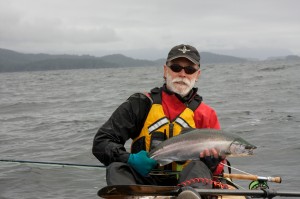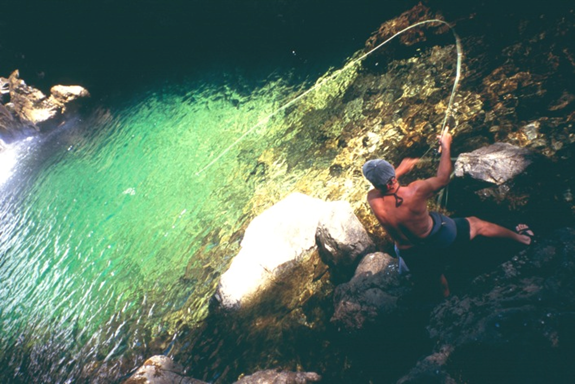Don’t miss the exciting, inspiring finish of Rob Lyon’s epic kayak tour along western Canada’s wild North Coast. You can read Part I of the story here.
I Ching, Hexagram #10, Treading, Six in the Third Place: “A one-eyed man is able to see, a lame man is able to tread. He treads on the tail of the tiger. The tiger bites the man.”
The word rhythm likely comes from the Greek word rhythmos, meaning “a strong, regular, repeated pattern of movement.” When we think of kayaking, we think of that graceful glide resulting from the rhythmic dip of the paddle. And then there are the existential rhythms. Like the unfailing rhythm that brings me to the North Coast each fall and returns me home again at trip’s end. Fractal-like, there’s also a day-to-day rhythm of traveling along the coast – the simple, alternating rhythm of sea and shore. The pattern is obvious; more subtle is the personal discovery that working within this natural rhythm can provide.
After years of two extreme styles of coastal paddling – expedition style trips with the MO of paddling whenever conditions were amenable, or the other extreme (that my friends swear by), traveling to a remote beach and going native for three weeks – I’ve developed a more organic, more rhythmic approach. It’s as simple as being on the water when I feel like it and being on the beach when I don’t. And, frankly, I love the shore as much as the sea. The opening I Ching hexagram sums up the Tao of this attitude. The lame man and the blind man get bit by the tiger. Why? Because they are not prepared to deal with it. For paddlers, this means developing healthy, powerful rhythms of action: go when we’re ready, stay when we’re not.
 Of course, life is never that easy. Ocean kayakers have a myriad of factors affecting decisions about when to travel or when to go ashore. Think of the natural rhythms as a template for action. In a perfect world you’ll always be fully where you are in body, mind and soul.
Of course, life is never that easy. Ocean kayakers have a myriad of factors affecting decisions about when to travel or when to go ashore. Think of the natural rhythms as a template for action. In a perfect world you’ll always be fully where you are in body, mind and soul.
That’s the ride Joe and I were on. We established an easy, natural rhythm of hitting the water when we were good and ready, paddling for a day or two, then finding a cool beach, islet or lagoon to make our new home. Inevitably, three, four or five days later we’d be ready for another salty tour.
***
The outer coast of Haida Gwaii’s Moresby Island is a place of stunning transition. The island’s mountainous spine rises straight up from the dark oceanic depths with a gates-of-heaven majesty. With the continental shelf plummeting swiftly not far to the west, the water off the tip of the Brooks has a similar feel. Paddling off the tip of the Brooks is sauce for the soul. Deep green water, the boom of swell-cum-wave against jagged black sea stacks. My soul hums and I respond with whoops of joy. I paddle closer to Joe and coax a laugh from him. It’s a day as fine as any. Seagulls gyre and call and three grays corkscrewed beside us performing a whale ballet.
We both hung a hard left, paddling just under heart attack level with me glancing over my left shoulder expecting to see a big boomer rise up like a monster out of a nightmare.
We approach Solander Island as the tide starts to turn. In our dance with this drunken giant, tempo and timing – part of those natural rhythms – are key. As we round the corner, I point to a tiny, rock-guarded cove. (You would miss it coming from the other direction.) I’d used this cove on several occasions to stage for a dash around the cape. I told Joe about the time I’d holed up there with a group to wait out a storm. The next morning, I rolled out of my tent to find two members of the team packing up. They’d decided to hike over the Cape. They had girlfriends camped on the south shore, and my theory is that they could smell the drifting pheromones. With no pheromone-emitting partners nearby, another guy and I prudently decided to wait out the big seas and paddle around when we could. End of story, the other two guys eventually made it to their girlfriends, thoroughly beaten and bloodied. Then they had to hike back to get their boats! Ah, the things men will do for the scent of a woman.
Joe and I rafted up for a moment and shared a Clif Bar and some cold coffee. Then we threw out bucktail flies for salmon and trolled into Brooks Bay where I hooked a small salmon that fed us for several meals. Reaching the entrance to the lagoon, we surfed onto a sandy beach rising into grassy dunes and a view of the rugged Refugium Range beyond, so named because these mountains were a refuge for life during the last ice age.
 We met some kayakers in the lagoon who had seen the ill-fated kayaker eulogized by that effigy we’d found (see North Coast Rhythms: Part I). They’d seen him paddling back towards Solander – no doubt the last people to see him alive.
We met some kayakers in the lagoon who had seen the ill-fated kayaker eulogized by that effigy we’d found (see North Coast Rhythms: Part I). They’d seen him paddling back towards Solander – no doubt the last people to see him alive.
“The guy looked weary, you know, and a little disoriented.”
And with a friggin’ gale about to blow, I thought. Talk about Toad’s Wild Ride. A few rudimentary skills, a little timing with that rhythm, even just some basic common sense, could have saved him.
The lagoon was the pinnacle of our trip. There was a lot to explore. Nestled in a corner of Brooks Bay, billowing dunes guarded the lagoon from the surf-swept ocean beach. We waded out at low tide to dog for sweet, fresh dungeness crab. We fly fished for flounder in the sand and for sea-run cutthroat and salmon in the channel. Mike’s River beckoned in the far corner of the lagoon; we spent a day wading and paddling as far upstream as we could, hoping to reach Gaultheira Lake, but finally retreating to catch the flood tide. One day we paddled to the far bank of the channel and bushwhacked over a ridge to a long, empty beach noisy with breakers. We weathered a massive storm, tucked behind the dunes in our tents with books and games and BC’s finest malt liquor.
After a week, our cups were full again.
“Whadaya say we think about heading back?” Joe suggested.
“Sounds good,” I said. “We’ve done about everything we wanted here. Be nice to get back on the water. Not to mention we’re out of beer.”
“We can tackle that cape again,” Joe said sardonically.
“You OK with that?”
“We have an option?”
We laughed.
“Well, no,” I said. “But you seemed comfortable enough out there on the way here.”
“It’s just a bit big for a guy from Montana,” Joe admitted. “I’m sure I’d get used to it if I came out here every year. But I’m good.”
“You’re right, shit does float,” Joe added. “I can see that, feel it even, sometimes. Let’s do it.”
That’s my buddy. Something I’ve learned about Joe over the years is that he knows when he’s done with something. He may not feel totally comfortable with what he’s heading into, but he doesn’t look back, and he brings the game he’s got. He knows the difference between a real threat and a spook in his head. He’s learning to evaluate situations as they come along and deal with whatever fears might pop up. And he is willing to deal with that, I think, because he digs what he’s doing and because he knows it’s eminently more doable than it appears.
I checked the tide book, hoping to time our exit with the slack tide. We packed up camp, rode the flashing ebb through the channel and bucked out through breaking waves, whooping aloud from all the excitement.
And speaking of spook, our return trip around the tip turned out to be some of the scariest paddling I’d ever experienced. While making a wide end run around Clerke Point, where a reef extends nearly a mile out to sea, we encountered a long line of breakers that collapsed only intermittently near the very end, and so we could never be certain we’d gone wide enough. We called out each time we saw a fresh break and were nearly ready to make the turn when I glanced beyond Joe and my stomach lurched. Some serious gnashing, churning, cresting white-capped waves had suddenly developed. The sight spooked me hard. What’s worse, the mass of waves was moving, and from my perspective, it appeared to be coming our way. I can only imagine how Joe felt! I called out to him and we both hung a hard left, paddling just under heart attack level with me glancing over my left shoulder expecting to see a big boomer rise up like a monster out of a nightmare. Finally, we made it safely into Checleset Bay.
That was our journey’s climax, and from there we coasted downhill. Our rhythms changed subtly, as they do on the homeward leg of any trip. We lingered a little less on every beach and paddled longer each day. Before long, we were back in our rig and hauling out over the coastal mountains, returning to civilization once again. I, for one, was ready. Joe would develop his own North Coast rhythm, about a five-year meter, while I knew I’d be back next year for my annual fix.
I don’t pretend to understand the immeasurably profound and complex draw the ocean has upon humanity. I once wrote that “water is to God as rivers are to man.” I understand this analogy almost viscerally when I’m on the ocean. The ocean feels somehow ultimate, whereas other waters do not. The fact that the big pond covers 7/8 of the Earth’s surface plays into that, of course. But consider our essential makeup – how much of our own bodies are water and how surprisingly saline we are.
Just the other day, I read that Navy doctors in World War II successfully used seawater in transfusion when blood serum ran out.
Think about that.



